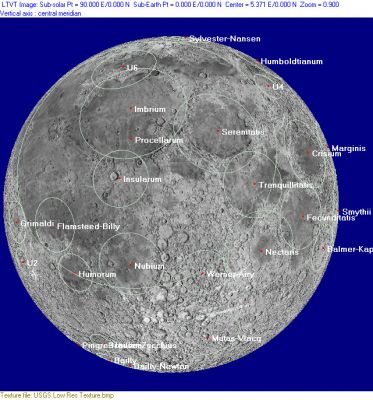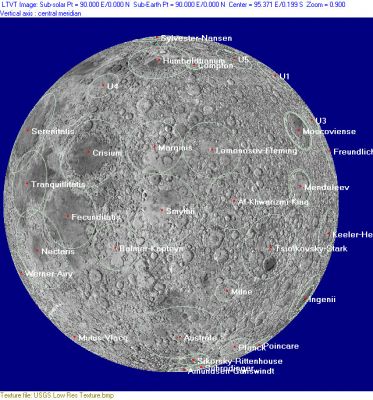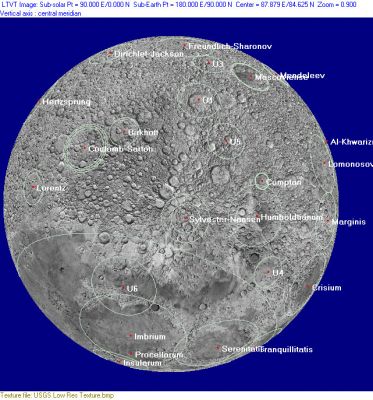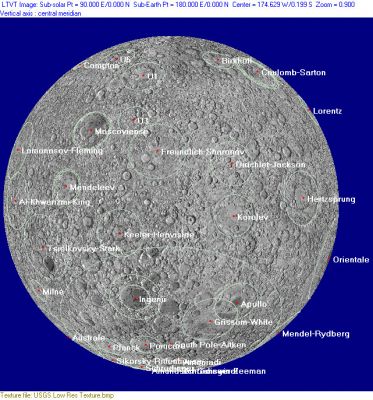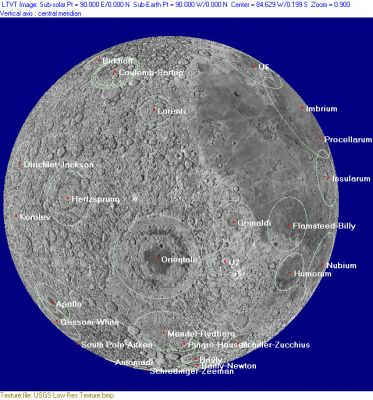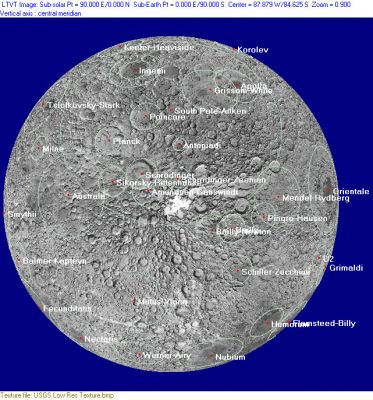Lunar Basins List
Contents
List of Lunar Basins
Lunar Basins & their Names
Originally published on 24 Oct 2003 by Chuck Wood on Observing the Sky blog
For hundreds of years nearly all observers of the Moon overlooked lunar basins. Basins are the largest craters on the Moon, but they weren’t recognized because nearly all of the ones on the Earth-ward facing hemisphere are filled with mare lava flows. Once Bill Hartmann, then a graduate student of Gerard Kuiper, started projecting telescopic images of the Moon onto a large white globe, the circular structure of Orientale and other basins became obvious.
Giant impact craters or basins with diameters larger than 300 to 400 km have a different morphology than smaller craters. Copernicus (93 km) is the type example of a large lunar crater, with terraced walls and significant central peaks. Basins are giant craters larger than 300 km that have two or more concentric rims and no central peak. The easiest basin structure to see on the near side of the Moon surrounds Mare Nectaris. The Altai Scarp is a very prominent piece of the main 860 km wide rim of the Nectaris impact basin. Another rim or ring is defined by the edges of the Mare Nectaris lavas, with the Pyrennes Mts being about the only part of this 400 km wide ring with significant topography. Another, more fragmentary 620 km ring, is barely traceable passing thru the craters Catharina and Columbo.
The concentric rings of Nectaris are believable once Orientale is seen. This 930 km basin just over the western limb of the Moon is a beautiful bulls-eye 3 ring basin, with rings clearly visible because only small amounts of lava have reached the surface.
Once Orbiter 4 photographs provided high resolution images of the entire Moon, Bill Hartmann and I did a study of multi-ring basins all over the Moon. We recognized basin structure around 10 maria on the near side and discovered 14 basins on the far side of the Moon. In fact, all of the lunar maria are contained within basins, although the multi-ring structure is difficult to detect at Fecunditatis, Tranquillitatis and Nubium. Oceanus Procellarum doesn’t seem to fit this theory because its not a circular mare deposit. But in a later article I will describe the Procellarum mega-basin.
Naming basins on the lunar nearside was easy since most of them are filled with mare lavas. Thus, there is the Imbrium basin, the Humorum basin, the Crisium basin, etc. Hartmann and I also described three other basins that lacked significant maria and were generally considered craters: Bailly, Grimaldi and Pingre. Their names already existed. We also described another basin that was not filled with dark mare material and had no crater name. The Basin near Schiller (our name) is a well-defined two ring basin whose outer ring passes under Schiller, near Rost and around to the where Segner and Zucchius meet. The lunar surface inside this arc is smooth like maria, but not dark. Outside the ring is old, heavily crater terrain. The inner ring passes near the limbward side of Schiller as a ridge, continues NW of Weigner and goes under Segner.
This lovely, overlooked basin was actually discovered by Kuiper’s son Paul who was helping with the photography of the projection globe. Hartmann and I were comfortable with the descriptive name ”Basin near Schiller” and we also called another battered basin the ”SE Limb Basin”. Losing our sense of geography we called two others ”Unnamed A” and "Unnamed B” - sort of like Dr Seuss’ Thing 1 and Thing 2!
The United States Geologic Survey had a large lunar mapping team in the 1960s and two of them (Stuart-Alexander and Howard) independently mapped multi-ring basins on the lunar farside. The USGS folks ultimately named basins after two bounding craters. Thus, our ”Basin near Schiller” was renamed ”Schiller-Zucchius Basin” and our ”SE Limb Basin” became ”Mendel-Rydberg”. So although Hartmann had originally discovered basins in the early 1960s, and he and I discovered and named others in 1971, the USGS names have taken hold because the USGS published maps with basin names! Sigh.
Reference: W.K. Hartmann and C.W. Wood (1971) Moon: Origin and Evolution of Multi-ring Basins. The Moon 3, 3-78.
List
The following images illustrate the positions of the basins named in the following list as viewed from the six cardinal directions. Click on the images for larger versions.
| Front |
East |
North |
| Back |
West |
South |
A
Al-Khwarizmi-King (farside basin) - Amundsen-Ganswindt (S pole - farside basin) - Antoniadi (farside basin) - Apollo (farside basin) - Australe (SE limb basin)
B
Bailly (SW limb basin) - Bailly-Newton (S pole - SW limb basin) - Balmer-Kapteyn (nearside basin) - Birkhoff (farside basin)
C
Compton (farside - NE limb basin) - Coulomb-Sarton (farside basin) - Crisium (nearside basin) (an additional C-basin could be the Cognitum basin, of which only the western part of its rim remains visible as Montes Riphaeus) (the creation of the Cognitum basin is seen in a series of paintings made by Don Davis, see page 89 of Carl Sagan's Cosmos) (the violent creation of the Imbrium basin and other impact craters).
D
Dirichlet-Jackson (farside basin)
E
(none)
F
Fecunditatis (nearside basin) - Flamsteed-Billy (nearside basin) - Freundlich-Sharonov (farside basin)
G
Grimaldi (nearside basin) - Grissom-White (farside basin)
H
Hertzsprung (farside basin) - Humboldtianum (NE limb basin) - Humorum (nearside basin)
I
Imbrium (nearside basin) (the violent creation of the Imbrium basin is depicted in a series of paintings from Don Davis, see page 89 of Carl Sagan's Cosmos), Ingenii (farside basin) - Insularum (nearside basin)
J
(none)
K
Keeler-Heaviside (farside basin) - Korolev (farside basin)
L
Lomonosov-Fleming (farside basin) - Lorentz (farside basin)
M
Marginis (E limb - nearside basin) - Mendeleev (farside basin) - Mendel-Rydberg (SW limb - farside basin) - Milne (farside basin) - Moscoviense (farside basin) - Mutus-Vlacq (nearside basin)
N
Nectaris (nearside basin) - Nubium (nearside basin)
O
Orientale (SW limb - farside basin)
P
Pingré-Hausen (SW limb - farside basin) - Planck (farside basin) - Poincaré (farside basin) - Procellarum (nearside basin)
Q
(none)
R
(none)
S
Schiller-Zucchius (Schiller Annular Plain) (nearside basin) - Schrödinger (farside basin) - Schrödinger-Zeeman (farside basin) - Schwarzschild (N pole - farside basin) - Serenitatis (nearside basin) - Sikorsky-Rittenhouse (farside basin) - Smythii (E limb basin) - South Pole-Aitken (S pole - farside basin) - Sylvester-Nansen (N pole basin)
T
Tranquillitatis (nearside basin) - Tsiolkovskiy-Stark (farside basin)
U
(none)
V
(none)
W
Werner-Airy (nearside basin)
X
(none)
Y
(none)
Z
(none)
Unnamed basins:
U1: centre of basin at d'Alembert
U2: centre of basin at Darwin
U3: centre of basin at Trumpler
U4: centre of basin at Lacus Temporis
U5: centre of basin at Olivier
U6: centre of basin at La Condamine/ Mare Frigoris
Additional list of unofficially named (so-called) basins on the moon's near side:
Loro Basin (printed on the Rand McNally moonmap, west of Airy).
Lost Basin (NASA name, see LPOD US-1 and Other Signposts).
Mishqui Basin (printed on the Rand McNally moonmap, north of Abbot).
Ruin Basin (NASA name, see LPOD US-1 and Other Signposts).
Smokey Basin (NASA name, see LPOD US-1 and Other Signposts).
Wash Basin (NASA name, see LPOD US-1 and Other Signposts).
Additional research: - DannyCaes Sep 9, 2015
An overview of the many suspected remains of possible ancient basins or large craters, depicted as circle-shaped dotted lines on the charts of the SLC (System of Lunar Craters, 1966)
Lunar northpole region (east to west)
B1 - ENDYMION
- An unnamed basin or large crater between De La Rue and Endymion, see SLC-B1.
C1 - SHEEPSHANKS
- Lamech's Danjon between Gartner and Kane, see SLC-C1 (on this chart, this ancient crater is not named).
D1 - FONTENELLE
- Ancient Newton south of Plato, see SLC-D1 and SLC-D2 (on these charts, this well-known ancient crater is not named).
- An unnamed small basin or large crater south (or southeast) of Philolaus, see SLC-D1 (not to be confused with the valley-shaped J.J.Cassini midway between Philolaus and Anaxagoras).
- An unnamed basin or large crater west of Carpenter, which is rather difficult to detect on SLC-D1 and SLC-E1.
E1 - HARPALUS
- See D1 for the unnamed basin or large crater west of Carpenter.
A2 - GAUSS
- An unnamed crater south of Berzelius, see SLC-A2 (on this chart, this ancient crater is not named).
B2 - LACUS SOMNIORUM
- Lacus Temporis, northeast of Chevallier, see SLC-B2 (on this chart, this so-called lake is not named) (this is probably the same as the basin U4, see list of 6 unnamed basins above).
C2 - MONTES CAUCASUS
- An unnamed crater north of Cassini, east of Promontorium Agassiz, see SLC-C2.
- The unnamed ghost crater north of Aristillus, see SLC-C2 (although very easy to observe, it doesn't have a letter-designation or name, and that's a mystery).
- Earhart (an unofficial name from R.Sood, L.Chappaz, and J.Melosh for a previously unknown large crater (diam. 200 km) of which the central part of it is located E.N.E. of the small bowl-shaped crater Eudoxus J, roughly speaking that's in the centre of the triangle Eudoxus - Lacus Mortis - Mare Serenitatis).
D2 - MARE IMBRIUM
- Ancient Newton, see D1.
E2 - MAIRAN
- An unnamed crater east-southeast of Gruithuisen, see SLC-E2.
F2 - LAVOISIER
A3 - MARE ANGUIS
- See B3 for the larger unnamed crater surrounding Esclangon.
- An unnamed crater southeast of Fredholm (including Fredholm on the northwestern part of its floor!), see SLC-A3.
B3 - MONS ARGAEUS
- An unnamed basin (?) or large crater (?) in the eastern part of Mare Serenitatis, west-southwest of Posidonius, see SLC-B3 (this must be a more-or-less circle shaped arrangement of wrinkle ridges, not the remains of a real basin or crater).
- A larger unnamed crater surrounding Esclangon, see SLC-B3 (on this chart, the small crater which is nowadays officially known as Esclangon was still called Macrobius L).
C3 - SULPICIUS GALLUS
D3 - WALLACE
- An unnamed crater immediately north of Mons Ampere, see SLC-D3.
- An unnamed crater slightly east of Archimedes W, see SLC-D3.
E3 - EULER
- An unnamed crater north of Prinz, see SLC-E3.
- An unnamed crater at the section of Montes Carpatus which was once called Sinus Pietrosul by J.N.Krieger, see SLC-E3.
F3 - STRUVE
- Not mentioned on this chart: the possible large crater south of Aristarchus and Herodotus, known as South AP (South of the Aristarchus Plateau).
Lunar equatorial belt (northern part) (east to west)
A4 - MARE UNDARUM
- An unnamed crater between Taruntius and Lawrence, see SLC-A4.
B4 - MARE TRANQUILLITATIS
- An unnamed crater east of Carrel, an unnamed crater north-northwest of Cajal, an ellipse-shaped formation east of Lamont, and another unnamed crater (?) west of Mount Marilyn (Secchi Theta), see SLC-B4.
C4 - HYGINUS
D4 - SINUS AESTUUM
- An unnamed crater about halfway between Pallas and Schroter, see SLC-D4.
E4 - HORTENSIUS
- Two overlapping unnamed craters south-southeast of Reinhold, see SLC-E4.
F4 - REINER
- An unnamed basin or crater west of Kepler, of which two Greek lettered hills of its rim (Kepler Kappa and Kepler Pi) are depicted on SLC-F4.
Lunar equatorial belt (southern part) (east to west)
A5 - LANGRENUS
- The northern part of the Balmer-Kapteyn Basin, see SLC-A5 (for the southern part see A6) (on these charts, this ancient basin is not named).
B5 - TORRICELLI
- An unnamed basin south of the section of Rimae Hypatia which was once called U.S. Highway Number One (this was a well-known signpost during the heydays of the Apollo program) (the equatorial missions such as Apollo 10 and Apollo 11), and another unnamed basin (or large crater?) east of the larger Hypatia basin, and there's also an unnamed crater (or small basin?) northeast of Ibn Rushd (west of Theophilus), see SLC-B5.
C5 - HIPPARCHUS
- Two unnamed basins or large craters east and southeast of Hipparchus. See SLC-C5 (one southeast of Saunder, and one north of Descartes).
D5 - PALISA
- An unnamed basin or large crater west-northwest of Flammarion, and another smaller one a bit further northwestward (west of Sommering), see SLC-D5.
E5 - MONTES RIPHAEUS
- Why isn't there an extended dotted line (a large circle) at the arc-shaped Riphaeus mountains? (the Cognitum basin), see SLC-E5.
- There seems to be a much larger circle-shaped formation surrounding Euclides B (Norman), with Norman itself slightly off-center toward the southwestern part of the suspected larger crater's "rim", see SLC-E5. Investigation of the WAC Nearside - Big Shadows presentation on the ACT-REACT QUICK MAP (LROC) reveals a rather different appearance of this suspected larger crater. It's just a more-or-less arc shaped section of the eastern continuation of the system of wrinkle ridges officially known as Dorsa Ewing.
- North-northwest of Euclides B (Norman) there's another ancient crater, of which only the northern section is noticeable as an arc-shaped cluster of hillocks. Two of those hillocks have been known as Euclides Rho and Xi, see SLC-E5, and further to the west there's another ancient crater, only two arc-shaped remains of it are visible, once called Euclides Epsilon and Wichmann Rho, with an additional hillock called Wichmann Delta (east of Letronne D, aka Scheele).
- There seems to be a circle-shaped formation (or rather: the remains of a circle-shaped formation) south of Kuiper. See SLC-E5. The WAC Nearside - Big Shadows version of the ACT-REACT Quick Map (LROC) shows just a more-or-less arc shaped system of wrinkle ridges... My investigating eyes can't detect a circle-shaped formation. - DannyCaes Feb 18, 2017
- An unnamed crater southeast of Lansberg, with a smaller unnamed one attached to the southwestern part of its rim, see SLC-E5.
F5 - GRIMALDI
- An unnamed basin (?) or large crater (?) southwest of the Flamsteed P ring, see SLC-F5 (could this be the centre of the Flamsteed-Billy Basin?).
- Damoiseau G ring or Dorsa Damoiseau G are two unofficial names from D.Caes for the more-or-less circle shaped system of wrinkle ridges between Damoiseau E (at southwest), Damoiseau G (at northeast), Damoiseau Ga (at southeast), and Damoiseau Gb (at northwest). The centre of this curious ring of wrinkle ridges is the location of a very small hillock which is nicknamed Tiny island by D.Caes. Could this be the uppermost summit of the pronounced central peak of a vanished large crater, of which only some ghost-like appearance of its upper rim remained? Note: nothing of this (of both the ring and the tiny hillock) is mentioned on SLC-F5.
A6 - PETAVIUS
- The southern part of the Balmer-Kapteyn Basin, see SLC-A6 (for the northern part see A5) (on these charts, this ancient basin is not named).
B6 - FRACASTORIUS
C6 - PLAYFAIR
- An unnamed basin or crater west of Airy, see SLC-C6 (this could be the Loro Basin, thus named on the Rand McNally moonmap).
- Two unnamed craters between Apianus and Werner, south of Krusenstern, one small crater inside the larger other, see SLC-C6.
- A larger crater surrounding Blanchinus, see SLC-C6.
D6 - ANCIENT THEBIT
- Ancient Thebit west of Thebit and including Thebit itself, surrounding Birt, Rupes Recta, and the Stag's Horn mountains, see SLC-D6 (on this chart, this ancient crater is not named).
E6 - AGATHARCHIDES
F6 - BYRGIUS
A7 - FURNERIUS
B7 - BRENNER
- Stiborius off-centre on the floor of a not quite circle-shaped larger formation, see SLC-B7.
C7 - STOFLER
D7 - TYCHO
- Saussure in the centre of (what seems to be) a much larger crater, see SLC-D7.
- J.H.Schroter's Rob. Smith between Brown D and Tycho D, southwest of Tycho. This crater is not named or lettered on D7, although the outline of this officially unnamed crater is noticeable!
E7 - HAINZEL
- The northern part of the Schiller-Zucchius Basin, for the whole of this basin see E8.
- The possible discovery of an unexpected basin southwest of Mare Humorum, see this new page.
F7 - PIAZZI
- Several large unnamed craters (or small basins?) between Vieta and Lehmann, see SLC-F7.
- For the possible discovery of an unexpected basin southwest of Mare Humorum, see E7.
Lunar southpole region (east to west)
B8 - BIELA
C8 - MANZINUS
- An unnamed basin or large crater in the centre of the quadrangle Pentland-Manzinus-Simpelius-Curtius, see SLC-C8.
D8 - CLAVIUS
E8 - PHOCYLIDES
- The Schiller-Zucchius Basin, aka the Schiller Annular Plain, see SLC-E8 (on this chart, this ancient basin is not named).
P.S.:
Wonderful audio-supplement for your investigations of suspected lunar basins and large craters:
- Ionica Minune's Hora Romaneasca (on YouTube, Electrecord - BestMusic.ro).
- Ion Onoriu's Hora Lautareasca (also on YouTube, among many others of the Electrecord label).
- and... much more quicksilvery rhythm in Vasile Pandelescu's music.
- DannyCaes Feb 8, 2017
